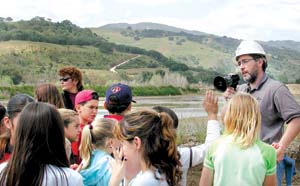
Parents, teachers and staff at Tres Pinos School District know
the rural school is a great place to get an education; it’s just
hard to pay for.
Parents, teachers and staff at Tres Pinos School District know the rural school is a great place to get an education; it’s just hard to pay for.
The school receives about $700,000 annually to support its student population of 138 plus six teachers, three recreational aides and a principal, but the money leaves little room for enrichment programs like fine arts and environmental studies. Programs like those have been cut in recent years because of continuous budget shortfalls of $10,000 to $15,000, according to Principal Luciano Medeiros.
“Because of the budget we’ve had to cut all non-essential programs,” Medeiros said. “As a small rural school, we receive less cash than bigger schools, which causes us to be very careful when deciding where the little money we get goes.”
With no transportation or food services, Tres Pinos School was getting to the point where it was strictly offering the bare minimum when parents and concerned members of the community jumped in. Three years ago, The Tres Pinos e3 Foundation was founded to help keep supplemental programs in the school and enrich the students’ lives with dance, choir, drama, life science and much more. Through the hard work and dedication of the people involved, Medeiros said, the foundation has raised about $15,000 to $20,000 a year for the school – just enough to keep the cuts from running too deep.
“The parent involvement at this school is just amazing,” Medeiros said. “These parents want to have more than just room mother support for the students.”
California state schools receive about $5,000 a year per student enrolled, according to San Benito County Assistant Superintendent Lawrence Elrod. When looking at the resources given to a smaller schools compared to larger schools, the efficiency of expenses has to do with economics of scale. The school itself is small in population and stature. The campus is but a few scattered buildings held close together by a playground just off Highway 25, but the district itself spans an impressive 200 square miles through true California country.
“A larger school has a larger base to have overhead costs spread out and more efficient,” Elrod said. “So basically, if you have a principal handling 450 students, the costs is going to be more efficient than the cost of a principal for 138. This leaves the bigger schools with more marginal money to employ.”
Since its inception, the e3 Foundation has provided an art teacher in 2002-2003, offered life science training to the teachers, provided Spanish as a second language in an after school program and provided music and voice classes during the last quarter of 2003. Because of the funding, a drama teacher is coming to the school twice a week to teach the students to express themselves and explore their personalities.
“I like having all the different programs because I get to learn a lot,” Fourth-grader Grace Tobias said.
Sixth-grader Matthew Lee agrees.
“I liked when we did the singing,” he said. “We sang ‘Lean on Me’ and that was a lot of fun.”
This year’s big fund-raiser will take place this weekend in Tres Pinos. Those who made donations will be taken back to 1848 when the Vaquero traditions thrived. After a trail ride through Santa Anita and Tobias ranches, supporters will be treated to a fine dining experience, and those who don’t wish to spend the afternoon on the trail have the option of enjoying wine tasting and cooking demonstrations at Dorothy McNett’s Place.
Parents Club President Lindsey O’Leary is impressed and very proud of the hard work the community and all involved have done.
“We’re always surprised at what kind of funds we can raise being such a small school,” O’Leary said. “If people can’t afford to donate monetarily, they donate their time. We’re just like a big ol’ family.”









